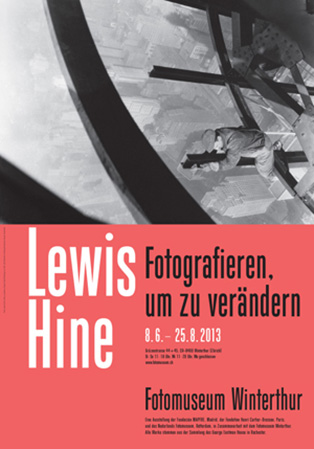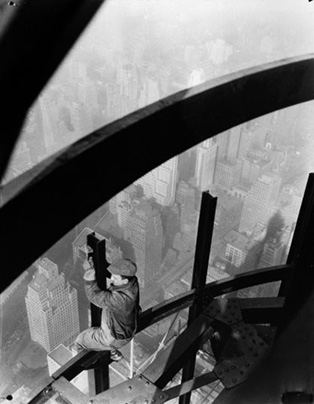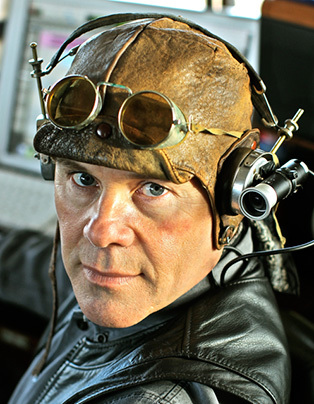

«LEWIS HINE – Fotografieren, um zu verändern»
Von Ingrid Isermann
Wie weit können Bilder gegen Ungerechtigkeiten und soziale Missstände wirksam werden? Auf diese Frage hat der amerikanische Fotograf Lewis Hine (1874–1940) mit seinem Werk eine frühe Antwort gegeben.
Der ausgebildete Lehrer und Soziologe wünschte enthusiastisch, dass sich die Amerikaner der Ungerechtigkeiten im amerikanischen Recht bewusst werden. Gleichzeitig stand er für die Überzeugung ein, dass jeder Mensch, jedes Individuum den vollen Respekt der anderen verdient. Fotografie, so seine Perspektive, war das beste Werkzeug, um dies sichtbar und deutlich zu machen. Lewis Hines Werk steht ganz am Anfang der grossen Tradition der engagierten, sozialdokumentarischen Fotografie, der sogenannten „concerned photography“.
Seine Bilder von Immigranten auf Ellis Island, von Kinderarbeit in amerikanischen Fabriken und von den Bauarbeitern des Empire State Building hoch über Manhattan sind zu zentralen Ikonen des 20. Jahrhunderts geworden. Gleichzeitig erinnern sie daran, dass die dokumentierten Missstände auch nach hundert Jahren nicht an Aktualität eingebüsst haben. Wir sehen heute selbst in Europa intensive Migrationsbewegungen, die in Zukunft weiter zunehmen werden. Kinderarbeit kennen wir hierzulande zwar nicht mehr, jedoch nur, weil wir die industriellen Produktionszweige, die mit Kinderarbeit operieren, in ferne Länder ausgelagert haben. Auch zeigen Unfälle in aussereuropäischen Fabriken, unter welch bedenklichen Umständen unsere Konsumgüter bis heute hergestellt werden. Hines fotografischer Blick und seine Schwarz-
Weiss-Fotografien spannen demnach einen direkten Bogen zur Gegenwart.
Lewis Hine wuchs in einem einfachen Restaurantbetrieb in der Kleinstadt Oshkosh, Wisconsin, auf. Mit 18 Jahren verlor er seinen Vater bei einem Unfall und sorgte vorerst als Fabrikarbeiter in einer Möbelmanufaktur, als Portier, Vertreter und Buchhalter für sich und die Familie. Nach einer Lehrerausbildung und einem Studium der Soziologie an der University of Chicago zog Hine nach New York, wo er an der Ethical Culture School erstmals mit der Fotografie in Kontakt kam: Er setzte die Kamera im Unterricht ein und porträtierte im Rahmen eines Forschungsprojektes die Immigranten auf Ellis Island. Fortan verstand Lewis Hine seine Kamera als Waffe, um gesellschaftliche Missstände aufzudecken und mit der Kraft der Bilder Veränderungen zu bewirken. Mit diesem inneren Auftrag reiste er für das National Child Labor Committee (NCLC) 75’000 km durch die Vereinigten Staaten und fotografierte Kinder bei ihrer Arbeit in der Landwirtschaft, in den Minen, Fabriken, Nähateliers und auf den Strassen. Seine Bilder sind nicht nur mitverantwortlich für ein neues Bewusstsein und erste Reformen gegen die Kinderarbeit. Ebenso begründen sie einen der frühesten und wichtigsten Beiträge zum Genre der sozialdokumentarischen Fotografie.
Das Fotomuseum Winterthur zeigt diese umfassende Retrospektive mit 170 Werken und vielen Werkdokumenten in Zusammenarbeit mit der Fundación MAPFRE (Madrid), der Fondation Henri Cartier Bresson (Paris) und dem Nederlands Fotomuseum (Rotterdam). Alle Werke stammen aus dem George Eastman House, International Museum of Photography and Film in Rochester, USA. Kuratorin: Alison Nordström.
Das Gesamtprojekt wurde von der Terra Foundation for American Art unterstützt.
Fotomuseum Winterthur (Halle und Galerie)
8. Juni bis 25. August 2013
www.fotomuseum.ch
Thomas Dolby and his invisible lighthouse
Julieta Schildknecht
«All I want is to make people happy»: His answer came within a lunch break a few hours before Thomas Dolby’s Screening Concert at Curzon Richmond, London.
A rainy spring sunday afternoon and the theater is full of old friends and fans, many of them with wet eyes, enjoying the refreshing work of a cult figure who returns to the art world after twenty years of chosen absence. One of the reasons to live in California for almost 23 years, is his family. The country where his wife, a former successful actress, comes from. Thomas Dolby decides to dedicate his time creating what didn’t exist until then: ring tones for celular phones. Besides that a pioneer work called TED, a «platform» which grew bigger than expected. a platform for scientists and academics; in his humbleness, people he highly admire.
Back in England, Suffolk, again he points out his family as the main reason for his decision: in England where the education offers more than what is offered in the United States.
Thomas Dolby, as the younger child of eight, grew up in a family surrounded by books, his mother was a mathematician and his father archeologist. The experience of a boarding school and many countries to visit due to his father profession enables a flair for history and art.
Books remain a must in the family, his wife owns a bookshop in suffolk : «It is a place to talk».
The documentary film is based on his enchanting past memories which are presented in paralel to a lighthouse in suffolk. This light tower plays a main role in the area where his ancesters once settled, where he spent part of his childhood and where he spends most of his time when not on tour either in America or Europe.
Quite pleasent the feeling while listening to his deep voice guiding us into his childhood fun memories. Quite surprising to realize how our child memories become forgotten due to a world overwhelmed with so many responsibilities.
The explorer canvas bag he carrys when entering the stage substitutes a pandora box of different objects, mainly his old guiness book, a pocket lamp and two small cameras which he used as a young filmmaker.
Thomas Dolby’s profound knowledge in eletronics together with his creativity qualify him to explore the most sophisticated devices delivering refreshing new songs just as „before“. His eyes glance when talking about his joy of playing piano again. Those «twenty years ago» are no gap but worked out as a good time to rethink much of his private life, space out in other fields of scientical discovery until he would miss his musical production so much to decide to compose new work and go public again.
His alternative life style and conscious approach towards our environment are the poetic side of his film. He tells about his electric car in the ninetees when it wasn’t trendy and I recall his boat „nutmeg of consolation“ where he built his studio.
The special colours and excentric details along the film show how important the lighthouse was during the second world war to England.
The film is not finished yet. Thomas Dolby wants to return to the lighthouse and work on some extra footage before the ministry of defence turns it inoperative. He wants his film to be about 50 minutes long.
Nevertheless, if he doesn’t receive a date before September to film on sight, he will take the risk and film without permission. Once the light at the tower is off, it will be abandoned and the sea will take the rest of the land which is left, over… just like many other lighthouses that sunk under the sea.
I ask if he is into politics and he promptly answers: „We do a lot of charity“.
My Richmond afternoon ends with a spontaneous encounter, after photographing Thomas Dolby, outside Curzon Theatre. Two friends and big fans of his start chating with me while sipping a beer and smoking their cigarrettes… we talk about Richmond, the main center of once new wave punk movement in England. We talk about what were their interests at that time. One of them shows me a black and white picture on his i-phone. Seven friends, in black suits and black ties twenty years ago. The picture was taken at their two floor building where they once runned a graphic design upstairs and a photo studio, downstairs. To commemorate the good old days, the days of Pink Floyd, Vivienne Westwood, Thomas Dolby and Kraftwerk in Germany, the same picture will be taken with them now, in black suits with black ties.
After all, an old trend which has been introduced by a young English middle class generation, once becoming a strong revival, is not here to be presented in museums but to be transformed as a source of inspiration for future generations.
The invisible lighthouse by Thomas Dolby
https://www.curzoncinemas.com/library/films/3124/thomas-dolby-the-invisible-lighthouse/
https://www.thomasdolby.com/tixstore/
On tour in England, Europe and America until September, 2013
The interactive game and cd with new compositions were launched in 2012 and are available to be purchased via website and amazon.


